Abolition, Direct Action and Veganism (myspace. com/285724656)
From: Organization that betrayed our Wildlife
THE UGLY REALITY OF MUTILATION
The word “mutilation," whose root means "to cut up; to cut off," is a disturbing one, but I’m not using it merely to disturb- I’m using it because it aptly describes what we systematically do to billions of live animals on a regular basis - because we can-To my mind, to mutilate someone physically, to harm them physically is the ultimate violation of their rights as an individual, but as we know, animals don't have rights - even over their own bodies- If it’s too painful for us to contemplate having the animals we love terrorized and cut up, I think we have to ask ourselves “what’s the difference for those animals for whom nobody is grieving?” It’s the same for them- It's not about us- It's about their suffering- It’s about them
HENS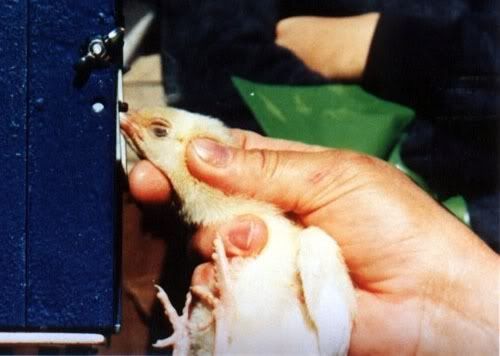
The most commonly known type of mutilation is "debeaking": the act of searing off a segment of a hen’s beak – while she is a chick - I say “she” because you should know by now that male chicks aren’t raised – they’re discarded, ground up, thrown out – cause well, they’re males- And males don’t lay eggs
To prevent economic losses from the frustrated birds pecking at one another and creating injury and death, it is perfectly legal and perfectly acceptable and perfectly widespread to cut off the beaks of the animals- This doesn’t stop the animals from pecking, of course – but it lessens the injury and thus lessens the economic losses
This procedure is often called "debeaking," which is a bit of a misnomer, because their entire beak isn’t removed- Some call it “beak trimming,” which I don’t like because it sounds as if the chick is going to the hair dresser- Whatever you call it, it is a painful procedure which involves cutting through bone, cartilage, and soft tissue with a searing hot blade- As the bird grows, their beaks are often so mutilated and still sensitive that it makes it difficult for them to eat and of course preen themselves- And sometimes, the birds’ beaks are seared a second time because the beaks can grow back – the first time is in their first week of life and if there’s a second time, it’s when they’re between 12 and 20 weeks of age
Visit http://www. eggindustry. com/ for more information
TURKEYS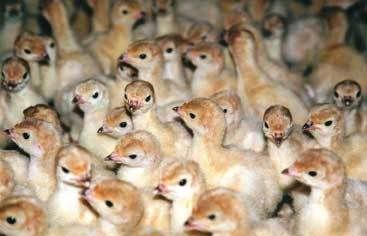
Turkeys are also raised in confinement in large sheds that are as large as football fields- As with the closely confined battery cage hens, the birds will become frustrated and exhibit stress-induced aggression- To minimize damage to the flesh and to the pocketbooks of the operators, baby turkeys (called poults) also undergo the painful procedure of having not only a portion of their beaks removed but also their toes- The babies are hung upside down, while the tips of their front three toes are exposed to microwave radiation, which kills the tissue- Often their toes are just cut off with scissors, and their snoods – the little piece of skin on the top of a turkey’s head – is pulled off (they say they do this to prevent damage from frostbite or fighting)- Sometimes their rear toes are also cut off with scissors – of course all of this without anesthesia
Visit www. upc-online. org
PIGS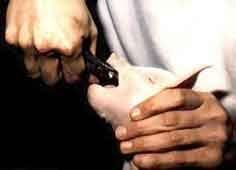
When piglets are only a couple weeks old, they’re mutilated in many ways- First comes the castration- The piglet’s scrotum is cut open by a worker, who pulls out his testicles while the piglet screams and writhes in pain- Just imagine for one second if this were a puppy or a kitten- It’s unfathomable- Next, their ears are notched
This is actually very common practice across the species - With scissors, a portion of each piglet’s ears are sliced off – just to make identification patterns- In addition, workers cut off piglets’ incisors with pliers that are similar to wire cutters, without the use of painkillers, in order to prevent them from biting each other – or chewing on themselves – out of boredom and frustration-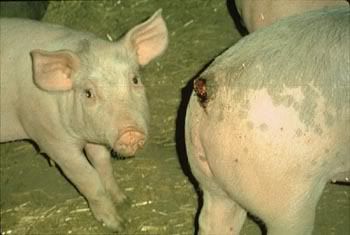
Finally, their tails are cut off to reduce tail biting, another habit that arises from boredom and frustration in stressful conditions- The pain is severe and continues for many days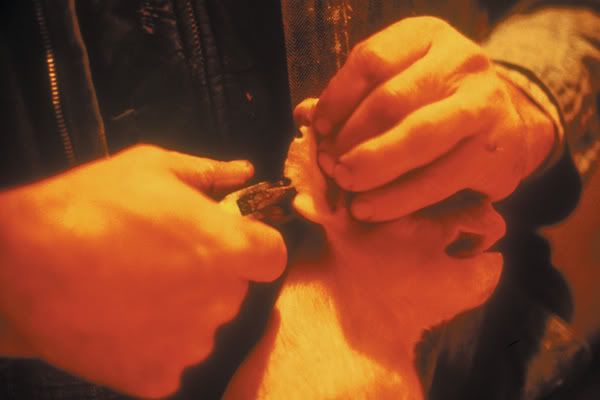
Visit www. pigspeace. org
CATTLE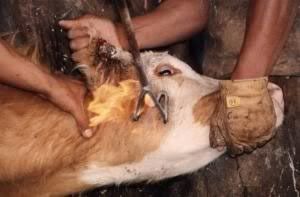
– BRANDING, DE-HORNING, EAR-NOTCHING I think the most obvious way that cattle are mutilated – something you’re all familiar with, and that’s branding- Branding – often done twice a year – is done by a rancher to register and identify his animals - All ranchers brand cattle, and most ranchers brand their horses too- The red hot steel tool, heated with a propane torch, is pressed into the side of the animal- Another method used is something called “freeze branding” which causes the hair to grow back white when it does grow back- This is no less painful than branding with a hot iron- This is done to “beef cattle” It’s not done with dairy cows because they are always kept close by so they can be milked several times a day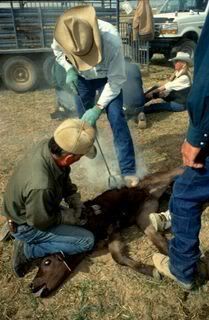
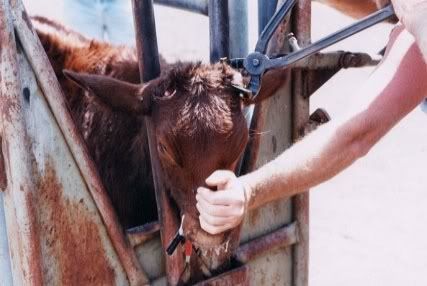
While the animal is restrained for the branding, this is also when they castrate the calves, cut off parts of their ears, and cut a slice of skin off their wattle, the fatty portion of the animal’s neck- I’ll say once again: all this is all done without anesthesia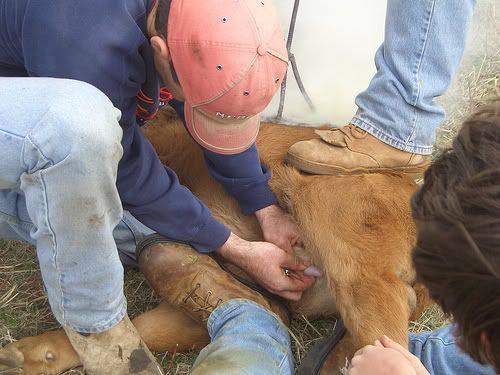
In what is called “ear marking,” portions of the ear are removed or cut, and they also cut the wattle so that when their skin heals, it hangs down in a certain identifiable position- All of this is done for identification purposes- Some ranchers use plastic tags secured to the cow's ear instead of the knife cut- I’ve helped removed these tags that are inserted without anesthesia or antiseptic, and the remaining hole is often bloody and crusty and raw
Something else that’s done to cattle when they’re enduring all of this – when they’re just calves – is dehorning and disbudding- Neither of these practices are regulated, and neither is done with anesthesia - Disbudding is the removal of the very early growth of what will become the horn if left to grow- The most common and most painful method is to use a hot iron - Dehorning is the removal of the horns after they have formed from the bud- Methods of dehorning include the use of wire, guillotine shears, or dehorning knives, or saws- Dehorning adult cattle is not advised – because their horns are connected to their sinus cavities, serious damage can occur, but it is done nonetheless
They remove the horns of cattle (females can have horns, too) for the same reason they cut off the beaks and toes of birds: to reduce the damage to the “flesh” caused by the cattle fighting or coming in contact to one another- The industry says “Horns are the single major cause of carcass wastage due to bruising, and trim associated with bruising for carcasses from horned cattle is approximately twice that for carcasses from hornless cattle”- In other words, the more the animals have “bruising” on their flesh, the less money for the people in the industry
DAIRY COWS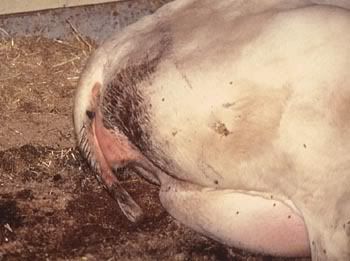
Though dairy cows aren’t branded, it doesn’t mean they don’t have pieces for their bodies removed- To increase the comfort of the workers who milk the cows – who attach the milking machines to their udders – a large portion of the cows’ tails are cut off- So the workers aren’t annoyed or inconvenienced- It’s called Tail Docking
If you’ve EVER spent one moment watching cattle, you’d know that they are constantly bothered by flies- Their tails are used to swat away flies and is the only way they are able to do this- The defenders of tail docking say that the risk of workers contracting Leptospirosis, which can be spread through the urine and can penetrate broken skin, is increased when the potentially urine-soaked tails hit the workers- But recent reviews of the science conclude that the available data do not support claims that tail docking reduces the risk of Leptospirosis - OR improves the dairy worker's comfort or safety- Experts discourage tail docking, and even the American Veterinary Medical Association criticizes this practice, and they don’t usually go against practices in the meat, dairy, and egg industries
By the way, the procedure is typically performed without anesthetic and is accomplished by the application of a tight, rubber ring that restricts blood flow to the bottom 2/3 of the tail, which atrophies and detaches or it’s removed with a sharp instrument
There’s another reeeeally disturbing practice that I couldn’t believe when I first heard about it- In fact, I wouldn’t have believed it if I didn’t see it with my own eyes- Have you heard of a fistulated cow? A fistulated cow is a cow who has had a hole cut into her side for scientific research- Then a plastic device – essentially a window – is inserted so that her digestive system can be observed- Fistulated cows are pretty common in animal ag/large animal vet programs/ag schools, and students are encouraged to stick their arms in and feel the stomach, etc -At agriculture fairs, this is essentially an attraction for visitors- But industry defends this as essential for understanding the health of the species- A cow with a window into her digestive system- Anyway, thought you might be interested in that
GOATS AND SHEEP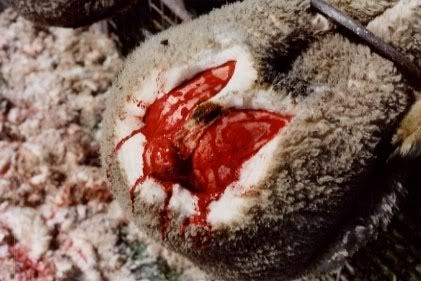
I mentioned before that pigs and cattle have pieces of their ears removed and are also ear-tagged- The same goes for goats and sheep- Goats also often have their horns and buds removed, an incredibly painful procedure- The reasoning behind this is similar to that used in the cattle industry – to reduce damage to the flesh but also to adapt the goat's head to fit into a milk stanchion- They cut off their horns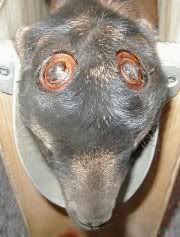
– which serve many practical purposes for the goats – to make it easier to get them through the milking line- Goats and sheep are also castrated without anesthesia, and goats also have their wattles cut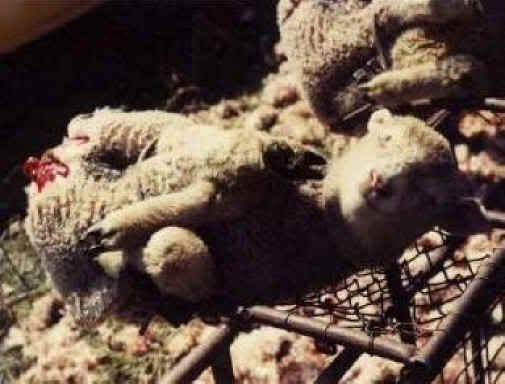
Sheep raised for their fur – which humans turn into what they call wool – endure something else entirely- You may have heard of something called mulesing
This is the name for the removal of pieces of skin from around the tail of a sheep- It’s common practice in Australia, where most sheep are raised for their fur- Defenders say it is a way to prevent flystrike (which is the incidence of maggots eating at their skin, and you can learn more about that on by doing some research on the lack of necessity of this cruel practice- Performed with large metal shears, no anesthetic is used
http://all-creatures. org/anex/sheep. html
DOGS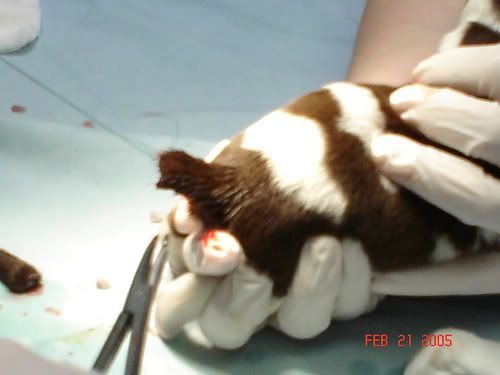
Dogs kept as research tools in laboratories have their vocal cords severed (and I’ve even heard of people doing this to their own dogs) -This is merely so that the researchers don’t have to listen to the dogs barking – ya know – communicating – all the time- Other ways we mutilate the animals we are supposed to love is by cropping the ears and tails of certain breeds of dogs – a cosmetic surgery – this is major surgery - that has no medical or practical purpose other than to continue this tradition and to meet the standards for certain breeds set forth by the American Kennel Club
CATS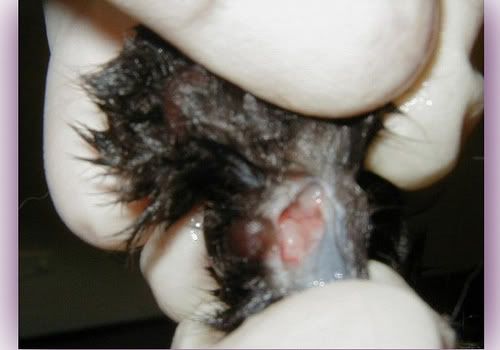
A hideous procedure that has gotten a lot of attention lately, thanks to activists and politicians who are banning this practice in many cities and states, is the declawing of domestic cats- Declawing is not a painless procedure, and it’s also not done for medical reasons- The cat's claw is not a toenail at the end of the toe as in other animals- It is movable digit attached to muscle as a finger might be- To declaw a cat is to cut off half of their toes- This is just another way that we just remove body parts for our own convenience
WILD ANIMALS KEPT AS PETS
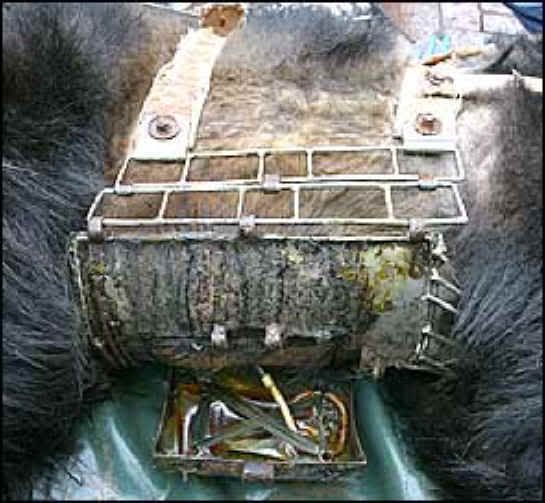
Finally and related to this is the barbaric act of keeping wild animals as pets- Aside from all of the ethical problems with this, people who do keep wild animals often have their claws and sharp teeth removed- The injustice of that is so striking to me – these dignified animals with their strength and dignity just cut off- It’s like the bear baiting of many years ago – when a declawed and detoothed bear was chained up and essentially mauled by a dog – for entertainment purposes- Also, if you don’t know about the bears in China confined in small cages practically no bigger than their own bodies just to extract the bile from their gallbladder – well their claws are removed- In addition, the bears are subjected to painful methods of bile extraction whereby a steel catheter is inserted into the abdomen- This is known as the "free-dripping" technique
For more on the farming of bears for their bile, please visit http://www. animalsasia. org/- It’s’ a fantastic organization that has been so incredibly effective at rescuing these bears and trying to ban this practice
Unfortunately, I think I’m probably leaving out some examples, but there you have it- The choices we make about animals' bodies comes down to human greed, gluttony, convenience, and vanity – not necessity
FFT
Note To My Critics:
The links to the many sites that I've included contain information that I believe to be relevant, be it the graphics, the videos, the undercover investigations, etc. . Exposing & and ending the brutality and savagery inflicted on the non-human animals is what I am focused on. I strongly believe that every voice against animal abuse/exploitation is of value and -and- collectively we have the power to end it. I am here for the animals, not for anyone's approval and for that I make no apologies. ** I do not promote violence towards humans.
___________________________________________________

Monday, March 9, 2009
The Ugly Reality of Animal Mutilation
Posted by Denbeath at 11:38 PM
Subscribe to:
Post Comments (Atom)














2 Comments:
i understand some of your argument. alot i can agree on but some of your agument is alittle one sided. like for exsample the ear tagging of a goat or cow this process is done yes without painkillers but it is as humans get there ears peirced it is but in the cartalige of the ear and i do understand that yes they can get infected if the get caught or an idiot doesnt so it right. another thing is branding yes it does cause pain but this only lasts for awhile and if it heals correctly then it sould be fine. this is a veiw from someone who aspires to be a large breed vet and has helped on ranches and hased work with a vet. mos small animal vets will prescribe painkillers to cats and dogs who have had ears cropped or claws removed i personally do not fell the need to have these procedurs done but it is like humans going to get beauty but on them though surgery or any thing like that. which brings me to the castration of cattle and such, cattle in the beef idustery are castrated for maximum weight put on also so that cows are not bred by bulls while gettong ready for slaughter this is again done for ANIMAL and human safty along with the dehorning. not only like you said bruises the meat but it could cause infection and the death of that animal if a horn stabbed it in the eye or cut the softer side or under belly. i am currently taking care of a show goat that was attacked by stray dogs that only attacked to injure he is sitting and a month later is only able to stand on three legs and i am trying to help get the fouth one to become usuable again but if it doesnt come back it will have to be removed and the dogs where shot do you think that is right for the dogs who mutalted a goat that i care for? or my sisters goat that was put down because of the bite wounds getting infected and even though the vets tried they couldnt get it to stop? i leave this comment because i find some of the points made true but others are one sided and need the full story.
Well here is the difference. Humans are in the position to decide weather or not to get their ears pierced or tattooed or ( I don't understand why one word) get branded. Animals do have that luxury to decide...humans make those decisions for them.
Post a Comment